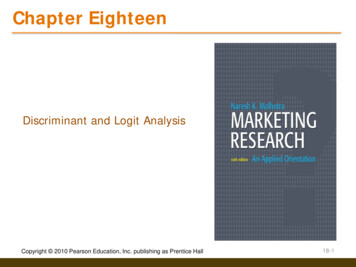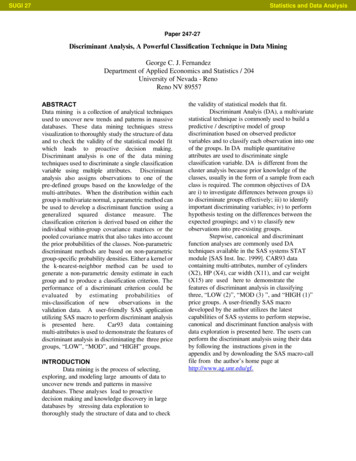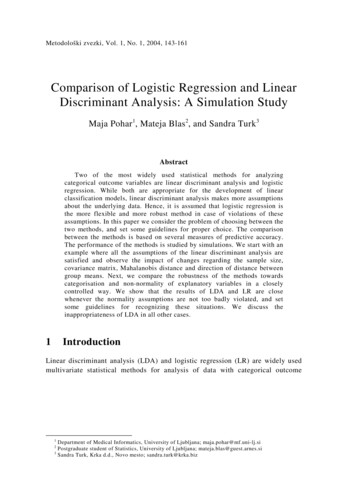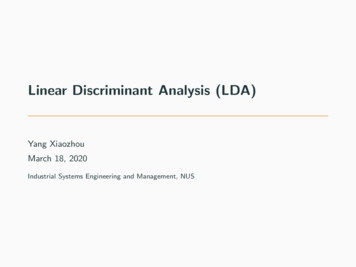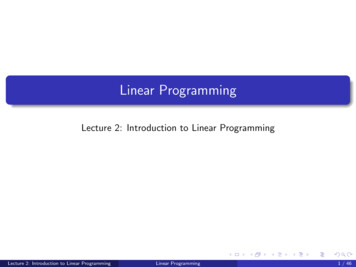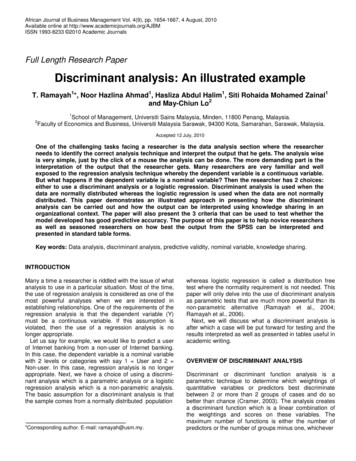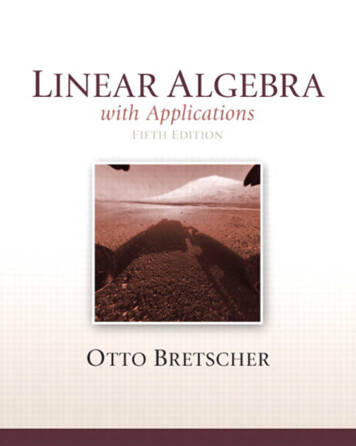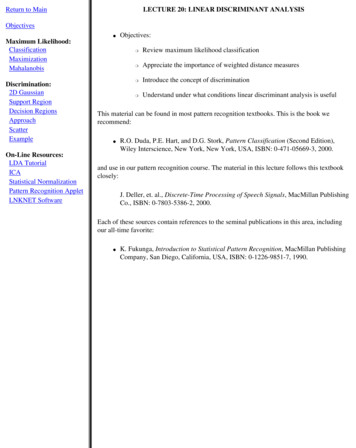
Transcription
Return to MainLECTURE 20: LINEAR DISCRIMINANT ANALYSISObjectives Maximum scrimination:2D GaussianSupport RegionDecision RegionsApproachScatterExampleOn-Line Resources:LDA TutorialICAStatistical NormalizationPattern Recognition AppletLNKNET SoftwareObjectives: Review maximum likelihood classification Appreciate the importance of weighted distance measures Introduce the concept of discrimination Understand under what conditions linear discriminant analysis is usefulThis material can be found in most pattern recognition textbooks. This is the book werecommend: R.O. Duda, P.E. Hart, and D.G. Stork, Pattern Classification (Second Edition),Wiley Interscience, New York, New York, USA, ISBN: 0-471-05669-3, 2000.and use in our pattern recognition course. The material in this lecture follows this textbookclosely:J. Deller, et. al., Discrete-Time Processing of Speech Signals, MacMillan PublishingCo., ISBN: 0-7803-5386-2, 2000.Each of these sources contain references to the seminal publications in this area, includingour all-time favorite: K. Fukunga, Introduction to Statistical Pattern Recognition, MacMillan PublishingCompany, San Diego, California, USA, ISBN: 0-1226-9851-7, 1990.
Return to MainIntroduction:01: Organization(html, pdf)Speech Signals:02: Production(html, pdf)03: Digital Models(html, pdf)04: Perception(html, pdf)05: Masking(html, pdf)06: Phonetics and Phonology(html, pdf)07: Syntax and Semantics(html, pdf)Signal Processing:08: Sampling(html, pdf)09: Resampling(html, pdf)10: Acoustic Transducers(html, pdf)11: Temporal Analysis(html, pdf)12: Frequency Domain Analysis(html, pdf)13: Cepstral Analysis(html, pdf)14: Exam No. 1(html, pdf)15: Linear Prediction(html, pdf)16: LP-Based Representations(html, pdf)17: Spectral Normalization(html, pdf)Parameterization:18: Differentiation(html, pdf)19: Principal Components(html, pdf)20: Linear Discriminant Analysis(html, pdf)Statistical Modeling:21: Dynamic Programming(html, pdf)ECE 8463: FUNDAMENTALS OF SPEECHRECOGNITIONProfessor Joseph PiconeDepartment of Electrical and Computer EngineeringMississippi State Universityemail: picone@isip.msstate.eduphone/fax: 601-325-3149; office: 413 SimrallURL: http://www.isip.msstate.edu/resources/courses/ece 8463Modern speech understanding systems merge interdisciplinary technologies from Signal Processing,Pattern Recognition, Natural Language, and Linguistics into a unified statistical framework. Thesesystems, which have applications in a wide range of signal processing problems, represent a revolutionin Digital Signal Processing (DSP). Once a field dominated by vector-oriented processors and linearalgebra-based mathematics, the current generation of DSP-based systems rely on sophisticated statisticalmodels implemented using a complex software paradigm. Such systems are now capable ofunderstanding continuous speech input for vocabularies of hundreds of thousands of words inoperational environments.In this course, we will explore the core components of modern statistically-based speech recognitionsystems. We will view speech recognition problem in terms of three tasks: signal modeling, networksearching, and language understanding. We will conclude our discussion with an overview of state-ofthe-art systems, and a review of available resources to support further research and technologydevelopment.Tar files containing a compilation of all the notes are available. However, these files are large and willrequire a substantial amount of time to download. A tar file of the html version of the notes is availablehere. These were generated using wget:wget -np -k -m ce 8463/lectures/currentA pdf file containing the entire set of lecture notes is available here. These were generated using AdobeAcrobat.Questions or comments about the material presented here can be directed to help@isip.msstate.edu.
LECTURE 20: LINEAR DISCRIMINANT ANALYSIS Objectives: Review maximum likelihood classification Appreciate the importance of weighted distance measures Introduce the concept of discrimination Understand under what conditions linear discriminant analysis is usefulThis material can be found in most pattern recognition textbooks. This is the book we recommend: R.O. Duda, P.E. Hart, and D.G. Stork, Pattern Classification (Second Edition), Wiley Interscience, New York,New York, USA, ISBN: 0-471-05669-3, 2000.and use in our pattern recognition course. The material in this lecture follows this textbook closely:J. Deller, et. al., Discrete-Time Processing of Speech Signals, MacMillan Publishing Co., ISBN: 0-7803-5386-2,2000.Each of these sources contain references to the seminal publications in this area, including our all-time favorite: K. Fukunga, Introduction to Statistical Pattern Recognition, MacMillan Publishing Company, San Diego,California, USA, ISBN: 0-1226-9851-7, 1990.
MAXIMUM LIKELIHOOD CLASSIFICATION
SPECIAL CASE: GAUSSIAN DISTRIBUTIONS
THE MAHALANOBIS DISTANCE
TWO-DIMENSIONAL GAUSSIAN DISTRIBUTIONSThe equation of multivariate Gaussian distribution is as follows:whereis the covariance matrix and d is the dimension of the distribution.1D Gaussian distribution2D Gaussian distribution
SUPPORT REGION: A CONVENIENT VISUALIZATION TOOL A support region is the surface defined by the intersection of a Gaussian distribution with a plane. The shape of a support region is elliptical and depends on the covariance matrix of the original data. A convenient visualization tool in pattern recognition.Some examples demonstrating the relationship between the covariance matrix and the 2D Gaussian distribution are shown below:Identity:UnequalVariances:Nonzero offdiagonal:Unconstrained:
DISTANCE MEASURES AND DECISION REGIONS Case I: Distributions withequal variancesDecision surface boundaryis a line separating the twodistributions (general caseis a hyperplane).Case II: Distributions withunequal variancesDirection of greatestvariance is not the directionof discrimination.
GOAL: MAXIMIZE SEPARABILITYPrincipal Component Analysis:Transform features to a new space inwhich the features are uncorrelated.Linear Discriminant Analysis:Projection of d-dimensional data ontoa line; Dimensionality reduction bymapping L distributions to (L-1)dimensional subspace; maximize classseparability.
OPTIMIZATION CRITERIA BASED ON SCATTER Within-class scatter defines the scatter of samples around their respective means. Between-class scatter defines scatter of expected vectors around the global mean. Mixture-class scatter is the overall scatter obtained from the covariance of all samples:where is the overall mean.Optimizing criteria used to obtain the transforms is a combination of within-class scatter, between-class scatterand overall scatter.Transformation matrix is given by:whereare the eigenvectors corresponding to non-zero eigenvalues.
A COMPARISON OF PCA AND LDAOriginal DataClass-Independent PCAClass-Independent LDA
INSTITUTE FOR SIGNAL AND INFORMATION PROCESSINGLINEAR DISCRIMINANT ANALYSIS - A BRIEF TUTORIALS. Balakrishnama, A. GanapathirajuInstitute for Signal and Information ProcessingDepartment of Electrical and Computer EngineeringMississippi State UniversityBox 9571, 216 Simrall, Hardy Rd.Mississippi State, Mississippi 39762Tel: 601-325-8335, Fax: 601-325-3149Email: {balakris, ganapath}@isip.msstate.edu
THEORY OF LDAPAGE 1 OF 81. INTRODUCTIONThere are many possible techniques for classification of data. Principle Component Analysis (PCA)and Linear Discriminant Analysis (LDA) are two commonly used techniques for data classificationand dimensionality reduction. Linear Discriminant Analysis easily handles the case where thewithin-class frequencies are unequal and their performances has been examined on randomlygenerated test data. This method maximizes the ratio of between-class variance to the within-classvariance in any particular data set thereby guaranteeing maximal separability. The use of LinearDiscriminant Analysis for data classification is applied to classification problem in speechrecognition.We decided to implement an algorithm for LDA in hopes of providing betterclassification compared to Principle Components Analysis. The prime difference between LDA andPCA is that PCA does more of feature classification and LDA does data classification. In PCA, theshape and location of the original data sets changes when transformed to a different space whereasLDA doesn’t change the location but only tries to provide more class separability and draw adecision region between the given classes.This method also helps to better understand thedistribution of the feature data. Figure 1 will be used as an example to explain and illustrate thetheory of LDA.Figure 1. Figure showing data sets and test vectors in original
THEORY OF LDAPAGE 2 OF 82. DIFFERENT APPROACHES TO LDAData sets can be transformed and test vectors can be classified in the transformed space by twodifferent approaches.Class-dependent transformation: This type of approach involves maximizing the ratio of betweenclass variance to within class variance. The main objective is to maximize this ratio so that adequateclass separability is obtained. The class-specific type approach involves using two optimizing criteriafor transforming the data sets independently.Class-independent transformation: This approach involves maximizing the ratio of overall varianceto within class variance. This approach uses only one optimizing criterion to transform the data setsand hence all data points irrespective of their class identity are transformed using this transform. Inthis type of LDA, each class is considered as a separate class against all other classes.3. MATHEMATICAL OPERATIONSIn this section, the mathematical operations involved in using LDA will be analyzed the aid of sampleset in Figure 1. For ease of understanding, this concept is applied to a two-class problem. Each dataset has 100 2-D data points. Note that the mathematical formulation of this classification strategyparallels the Matlab implementation associated with this work.1. Formulate the data sets and the test sets, which are to be classified in the original space. Thegiven data sets and the test vectors are formulated, a graphical plot of the data sets and testvectors for the example considered in original space is shown in Figure 1. For ease ofunderstanding let us represent the data sets as a matrix consisting of features in the formgiven below:a 11 a 12a 21 a 22set1 a m1 a m2b 11 b 12b 21 b 22set2 b m1 b m2(1)2. Compute the mean of each data set and mean of entire data set. Let µ 1 and µ 2 be the meanof set 1 and set 2 respectively and µ 3 be mean of entire data, which is obtained by mergingset 1 and set 2, is given by Equation 1.µ3 p1 µ1 p2 µ2(2)
THEORY OF LDAPAGE 3 OF 8where p 1 and p 2 are the apriori probabilities of the classes. In the case of this simple twoclass problem, the probability factor is assumed to be 0.5.3. In LDA, within-class and between-class scatter are used to formulate criteria for classseparability. Within-class scatter is the expected covariance of each of the classes. Thescatter measures are computed using Equations 3 and 4.Sw p j ( cov j )(3)jTherefore, for the two-class problem,S w 0.5 cov 1 0.5 cov 2(4)All the covariance matrices are symmetric. Let cov1 and cov2 be the covariance of set 1 andset 2 respectively. Covariance matrix is computed using the following equation.cov j ( x j – µ j ) ( x j – µ j )T(5)The between-class scatter is computes using the following equation.Sb ( µ j – µ3 ) ( µ j – µ3 )T(6)jNote that S b can be thought of as the covariance of data set whose members are the meanvectors of each class. As defined earlier, the optimizing criterion in LDA is the ratio ofbetween-class scatter to the within-class scatter. The solution obtained by maximizing thiscriterion defines the axes of the transformed space. However for the class-dependent transformthe optimizing criterion is computed using equations and (5). It should be noted that if the LDAis a class dependent type, for L-class L separate optimizing criterion are required for eachclass. The optimizing factors in case of class dependent type are computed ascriterion j inv ( cov j ) S b(7)For the class independent transform, the optimizing criterion is computed ascriterion inv ( S w ) S b(8)4. By definition, an eigen vector of a transformation represents a 1-D invariant subspace of thevector space in which the transformation is applied. A set of these eigen vectors whosecorresponding eigen values are non-zero are all linearly independent and are invariant underthe transformation. Thus any vector space can be represented in terms of linearcombinations of the eigen vectors. A linear dependency between features is indicated by a
THEORY OF LDAPAGE 4 OF 8zero eigen value. To obtain a non-redundant set of features all eigen vectors correspondingto non-zero eigen values only are considered and the ones corresponding to zero eigenvalues are neglected. In the case of LDA, the transformations are found as the eigen vectormatrix of the different criteria defined in Equations 7 and 8.5. For any L-class problem we would always have L-1 non-zero eigen values. This is attributedto the constraints on the mean vectors of the classes in Equation 2. The eigen vectorscorresponding to non-zero eigen values for the definition of the transformation.For our 2-class example, Figures 2 and 3 show the direction of the significant eigen vectoralong which there is maximum discrimination information. Having obtained thetransformation matrices, we transform the data sets using the single LDA transform or theclass specific transforms which ever the case may be. From the figures it can be observedthat, transforming the entire data set to one axis provides definite boundaries to classify thedata. The decision region in the transformed space is a solid line separating the transformeddata sets thusFor the class dependent LDA,Ttransformed set j transform j set j(9)For the class independent LDA,Ttransformed set transform spec data setT(10)Similarly the test vectors are transformed and are classified using the euclidean distance of thetest vectors from each class mean.The two Figures 4 and 5 clearly illustrate the theory of Linear Discriminant Analysis applied toa 2-class problem. The original data sets are shown and the same data sets after transformationare also illustrated. It is quite clear from these figures that transformation provides a boundaryfor proper classification. In this example the classes were properly defined but cases where thereis overlap between classes, obtaining a decision region in original space will be very difficultand in such cases transformation proves to be very essential. Transformation along largest eigenvector axis is the best transformation.Figures 6 and 7, are interesting in that they show how the linear transformation process can beviewed as projecting data points onto the maximally discriminating axes represented by theeigen vectors.6. Once the transformations are completed using the LDA transforms, Euclidean distance orRMS distance is used to classify data points. Euclidean distance is computed usingEquation 11 where µ ntrans is the mean of the transformed data set, n is the class indexand x is the test vector. Thus for n classes, n euclidean distances are obtained for each testpoint.
THEORY OF LDAFigure 2. Figure for eigen vector direction in class dependent typeFigure 3. Figure for eigen vector direction in class independent typePAGE 5 OF 8
THEORY OF LDAPAGE 6 OF 8Tdist n ( transform n spec ) x – µ ntrans(11)7. The smallest Euclidean distance among the n distances classifies the test vector asbelonging to class n .4. CONCLUSIONSWe have presented the theory and implementation of LDA as a classification technique. Throughoutthe tutorial we have used a 2-class problem as an exemplar. Two approaches to LDA, namely, classindependent and class dependent, have been explained. The choice of the type of LDA depends on thedata set and the goals of the classification problem. If generalization is of importance, the classindependent tranformation is preferred. However, if good discrimination is what is aimed for, theclass dependent type should be the first choice. As part of our future work, we plan to work on aJava-based demonstration which could be used to visualize LDA based transformations on userdefined data sets and also help the user apperiaciate the difference between the various classificationtechniques.Figure 4. Data sets in original space and transformed space along with the tranformation axis forclass dependent LDA of a 2-class problem
Figure 5. Data sets in original space and transformed space for class independent type of LDA of a2-class problem5. SOFTWAREAll Matlab code written for this project is available for public from our website atwww.isip.msstate.edu6. REFERENCES[1]K. Fukunaga, Introduction to Statistical Pattern Recognition, Academic Press, San Diego,California, 1990.[2]S. Axler, Linear Algebra Done Right, Springer-Verlag New York Inc., New York, New York,1995.
nRegioonecisiDtse1set2DecisionRegionFigure 6. Figure showing histogram plot of transformed data with decision region in class independent type and the amount of class separability obtained in transformed spacet1seset 2Figure 7. Histogram plot of transformed data with decision region in class dependent type and the amount ofclass separability obtained in transformed space
Paris' Independent Component Analysis & BlindSource Separation pageIndependent Component Analysis (ICA) and Blind Source Separation (BSS) have received quite a lot of attention lately sothat I decided to compile a list of online resources for whoever is interested. By no means is this page complete and if youhave any additions do send me mail. In the papers section I do not list all of the papers of every author (that's why youshould check their homepages) but the really good ones are here. Also not all ICA & BSS people have home pages so ifyou discover any or if I missed yours tell me about it and I'll add them.People working on ICA & BSS Pierre Comon, one of the first people to look at ICA, at the Laboratoire I3S of Universit? de Nice - SophiaAntipolis Tony Bell at the Salk Institute's Computational Neurobiology Lab Shun-ichi Amari at RIKEN's Lab for Information Synthesis Andrzej Cichocki at RIKEN's Laboratory for Open Information Systems Wlodzimierz Kasprzak at RIKEN's Laboratory for Open Information Systems Kari Torkkola at Motorola Erkki Oja at Helsinki University of Technology Laboratory of Computer and Information Science Juha Karhunen at Helsinki University of Technology Laboratory of Computer and Information Science Aapo Hyvarinen at Helsinki University of Technology Laboratory of Computer and Information Science Jean-François Cardoso at the Ecole Nationale Supérieure des Télécommunications Signal Department Barak Pearlmutter at the University of New Mexico CS Department Mark Girolami at the University of Paisley Department of Computing and Information Systems(Looking for students) Te-Won Lee at the Salk Institute's Computational Neurobiology Lab Adel Belouchrani at Villanova University's Department of Electrical and Computer Engineering Simon Godsill and Dominic Chan at the Signal Processing and Communications Group at Cambridge University Juergen Schmidhuber at IDSIA Henrik Sahlin at Chalmers University of Technology. Seungjin Choi at Pohang University of Science and Technology. Gustavo Deco at Siemens. Hans van Hateren at the University of Groningen. Daniël Schobben formerly at the Eindhoven University of Technology now at Phillips Vicente Zarzoso at the University of Strathclyde Kevin Knuth at the Albert Einstein College of Medicine Russ Lambert doing very cool things with sTrAnGe matrices! Alex Westner a brave man who scoffs at the complexity of real-world mixtures Daniel Rowe at Caltech, doing Bayesian BSS Michael Zibulevsky at the University of New Mexico Na Kyungmin at the Seoul National University Lieven De Lathauwer at the Katholieke Universiteit Leuven Scott Rickard at Princeton Lucas Parra at the Sarnoff Corp. Simone Fiori at the Perugia University Carlos G. Puntonet at the University of Granada Andreas Ziehe at GMD FIRST Fathi Salam at the Circuits, Systems and Artificial Neural Networks Laboratory, Michigan State UniversityOther ICA Pages Te-Won Lee's ICA-CNL Page. Allan Barros' ICA Page. Tony Bell's ICA Page. Daniel Rowe's Bayesian BSS Page.Benchmarks Daniël Schobben, Kari Torkkola and me maintain these: Real world benchmarks Synthetic benchmarksCode and Software . Code from Pierre Comon. The FastICA package by Aapo Hyvärinen (very cool, get it!) OOLABSS by Cichocki and Orsier. By Tony Bell, Here By Jean-François Cardoso: The EASI Algorithm. The JADE Algorithm (and its calling program). By Dominic Chan, Here RICA by Cichocki and Barros. Genie by Na Kyungmin. By me: Mostly old instantaneous ICA code (in MATLAB)Online Demos of BSS Barak Pearlmutter's Demo on Contextual ICA Te-Won Lee's Demo Dominic Chan's Demo My little frequency domain algorithm: (This is actually a static mix, I just put it up cause it sounds cool, but thealgorithm can deal with convolved mixtures too) The input sound. The speech output (and in slow motion) The noise output (and in slow motion) Henrik Sahlin's demo. Hans van Hateren's demo on images. Daniël Schobben's demo page Shiro Ikeda's demos Alex Westner's demos Scott Rickard's demo page Christian Jutten's JAVA demoOnline Papers on ICA & BSS(since I don't really sit around all day playing with this page, there some links that are extinct by now. Rather than givingup, check out the home page of the corresponding author in the top of the page. You are most likely to find their papersthere. You are also most likely to find their newer papers there too). Yes, I actually finished my dissertation! Smaragdis, P. 2001. Redundancy reduction for computational audition, a unifying approach. Ph.D.dissertation, MAS department, Massachusetts Institute of Technology. Smaragdis, P. 1997. Information Theoretic Approaches to Source Separation, Masters Thesis, MASDepartment, Massachusetts Institute of Technology.I realize that the name of the thesis is not terribly enlightening. What happens in there, apart fromthe obligatory background stuff, is the development of a new frequency domain separationalgorithm to deal with convolved mixtures. The idea is to move to a space where the separationparameters are orthogonal, to assist convergence, and to be able to implement at the same timefaster convolution schemes. In addition to this the algorithm is on-line and real-time so that youcan actually use it. Results are nice too!Smaragdis, P. 1997. Efficient Blind Separation of Convolved Sound Mixtures,IEEE ASSP Workshop onApplications of Signal Processing to Audio and Acoustics. New Paltz NY, October 1997.Pretty much the same material, geared towards DSP-heads. Written before my thesis so it is a littleoutdated.Smaragdis, P. 1998. Blind Separation of Convolved Mixtures in the Frequency Domain. InternationalWorkshop on Independence & Artificial Neural Networks University of La Laguna, Tenerife, Spain,February 9 - 10, 1998.Condenced version of my thesis. Most up to date compared to my other offerings.Tony Bell has some neat papers on Blind Source Separation: Bell A.J. & Sejnowski T.J. 1995. An information-maximization approach to blind separation and blinddeconvolution, Neural Computation, 7, 1129-1159. Bell A.J. & Sejnowski T.J. 1995. Fast blind separation based on information theory, in Proc. Intern. Symp.on Nonlinear Theory and Applications, vol. 1, 43-47, Las Vegas, Dec. 1995And a couple of papers on ICA alone: Bell A.J. & Sejnowski T.J. 1996. Learning the higher-order structure of a natural sound, Network:Computation in Neural Systems, to appear Bell A.J. & Sejnowski T.J. 1996. The Independent Components' of natural scenes are edge filters, VisionResearch, under review [Please note that this is a draft].Kari Torkkola has some practical papers on simultaneous Blind Source Separation and Deconvolution: Torkkola, K.:Blind Separation of Delayed Sources Based on Information Maximization. Proceedings ofthe IEEE Conference on Acoustics, Speech and Signal Processing, May 7-10 1996, Atlanta, GA, USA. Torkkola, K.:Blind Separation of Convolved Sources Based on Information Maximization. IEEEWorkshop on Neural Networks for Signal Processing, Sept 4-6 1996, Kyoto, Japan. Torkkola, K.:IIR Filters for Blind Deconvolution Using Information Maximizationrm. NIPS96 Workshop:Blind Signal Processing and Their Applications, Snowmaas (Aspen), Colorado.Barak Pearlmutter has a paper on context sensitive ICA: Barak A. Pearlmutter and Lucas C. Parra. A context-sensitive generalization of ICA. 1996 InternationalConference on Neural Information Processing. September 1996, Hong Kong.Erkki Oja has papers on PCA, nonlinear PCA and ICA: Oja, E., Karhunen, J., Wang, L., and Vigario, R.:Principal and independent components in neural networks- recent developments. Proc. VII Italian Workshop on Neural Nets WIRN'95, May 18 - 20, 1995, Vietri sulMare, Italy (1995). Oja, E.:The nonlinear PCA learning rule and signal separation - mathematical analysis. Helsinki Universityof Technology, Laboratory of Computer and Information Science, Report A26 (1995). Oja, E. and Taipale, O.:Applications of learning and intelligent systems - the Finnish technologyprogramme. Proc. Int. Conf. on Artificial Neural Networks ICANN-95, Industrial Conference, Oct. 9 - 13,1995, Paris, France (1995). Oja, E.: PCA, ICA, and nonlinear Hebbian learning. Proc. Int. Conf. on Artificial Neural Networks ICANN95, Oct. 9 - 13, 1995, Paris, France, pp. 89 - 94 (1995). Oja, E. and Karhunen, J.:Signal separation by nonlinear Hebbian learning. In M. Palaniswami, Y.Attikiouzel, R. Marks II, D. Fogel, and T. Fukuda (Eds.), Computational Intelligence - a Dynamic SystemPerspective. New York: IEEE Press, pp. 83 - 97 (1995).Juha Karhunen has written ICA & BSS papers with Oja (right above) and some on his own: Karhunen, J.:Neural Approaches to Independent Component Analysis and Source Separation. To appear inProc. 4th European Symposium on Artificial Neural Networks (ESANN'96), April 24 - 26, 1996, Bruges,Belgium (invited paper). Karhunen, J., Wang, L., and Vigario, R.,Nonlinear PCA Type Approaches for Source Separation andIndependent Component AnalysisProc. of the 1995 IEEE Int. Conf. on Neural Networks (ICNN'95), Perth,Australia, November 27 - December 1, 1995, pp. 995-1000. Karhunen, J., Wang, L., and Joutsensalo, J.,Neural Estimation of Basis Vectors in Independent ComponentAnalysis Proc. of the Int. Conf. on Artificial Neural Networks (ICANN'95), Paris, France, October 9-13,1995, pp. 317-322.Andrzej Cichocki organized a special invited session on BSS in Nolta '95 and has a nice list of papers on thesubject:(another apparently defunct set of links .) Shun-ichi Amari, Andrzej Cichocki and Howard Hua Yang, "Recurrent Neural Networks for BlindSeparation of Sources", , pp.37-42. Anthony J. Bell and Terrence J. Sejnowski, "Fast Blind Separation based on Information Theory", pp. 4347. Adel Belouchrani and Jean-Francois Cardoso, "Maximum Likelihood Source Separation by the ExpectationMaximization Technique: Deterministic and Stochastic Implementation", pp.49-53. Jean-Francois Cardoso, "The Invariant Approach to Source Separation", pp. 55-60. Andrzej Cichocki, Wlodzimierz Kasprzak and Shun-ichi Amari, "Multi-Layer Neural Networks with LocalAdaptive Learning Rules for Blind Separation of Source Signals", , pp.61-65. Yannick Deville and Laurence Andry, "Application of Blind Source Separation Techniques to Multi-TagContactless Identification Systems", , pp. 73-78. Jie Huang , Noboru Ohnishi and Naboru Sugie "Sound SeparatioN Based on Perceptual Grouping ofSound Segments", , pp.67-72. Christian Jutten and Jean-Francois Cardoso, "Separation of Sources: Really Blind ?" , pp. 79-84. Kiyotoshi Matsuoka and Mitsuru Kawamoto, "Blind Signal Separation Based on a Mutual InformationCriterion", pp. 85-91. Lieven De Lathauwer, Pierre Comon, Bart De Moor and Joos Vandewalle, "Higher-Order Power Method Application in Independent Component Analysis" , pp. 91-96. Jie Zhu, Xi-Ren Cao, and Ruey-Wen Liu, "Blind Source Separation Based on Output Independence Theory and Implementation" , pp. 97-102.Papers are included in Proceedings 1995 International Symposium on Nonlinear Theory and ApplicationsNOLTA'95, Vol.1, NTA Research Society of IEICE, Tokyo, Japan, 1995. Shun-ichi Amari wrote some excelent papers with the RIKEN people on BSS and the math behind it: S. Amari, A. Cichocki and H. H. Yang, A New Learning Algorithm for Blind Signal Separation (128K),In: Advances in Neural Information Processing Systems 8, Editors D. Touretzky, M. Mozer, and M.Hasselmo, pp.?-?(to appear), MIT Press, Cambridge MA, 1996. Shun-ichi Amari, Neural Learning in Structured Parameter Spaces , NIPS'96 Shun-ichi Amari, Information Geometry of Neural Networks - New Bayesian Duality Theory - ,ICONIP'96 Shun-ichi Amari, Gradient Learning in Structured Parameter Spaces: Adaptive Blind Separation of SignalSources , WCNN'96 Shun-ichi Amari and Jean-Francois Cardoso, Blind Source Separation - Semiparametric StatisticalApproach, sumitted to IEEE Tr. on Signal Processing. Shun-ichi Amari, Natural Gradient Works Efficiently in Learning, sumitted to Neural Computation. Howard Hua Yang and Shun-ichi Amari, Adaptive On-Line Learning Algorithms for Blind Separation Maximum Entropy and Minimum Mutual Information , accepted for Neural Computation. Shun-ichi Amari, Tian-Ping CHEN, Andrzej CICHOCKI, Stability Analysis of Adaptive Blind SourceSeparation , accepted for Neural
This material can be found in most pattern recognition textbooks. This is the book we recommend: R.O. Duda, P.E. Hart, and D.G. Stork, Pattern Classification (Second Edition), Wiley Interscience, New York, New York, USA, ISBN: -471-05669-3, 2000. and use in our pattern recognition course. The material in this lecture follows this textbook
